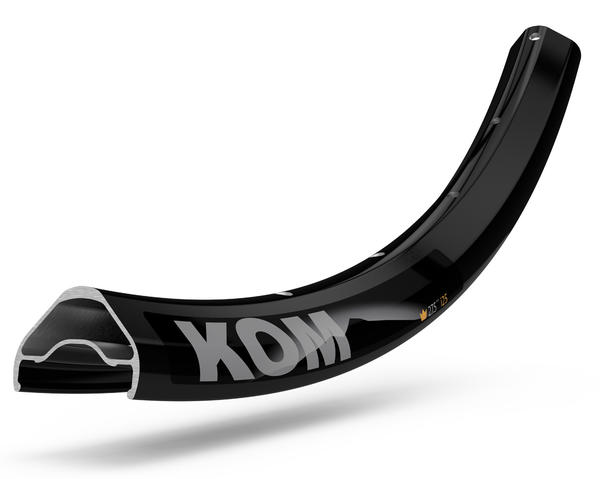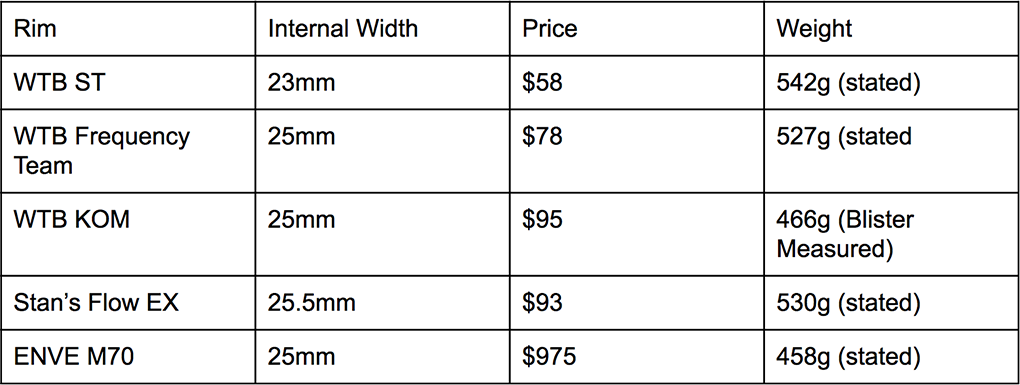
WTB KOM i25 27.5 Rim – First Look
Blister’s Measured Weight: 466 grams
Internal Width: 25mm
Effective Rim Diameter: 564mm
Wheel Build: DT Competition spokes / Hadley Hubs
Bike: Santa Cruz Nomad 27.5
Duration of test: 2 weeks
MSRP: $95
[Editor’s Note: After 25 days on the WTB KOM i25 rims, we’ve added an update on page 2 addressing their durability and offering more comparisons.]
Stan’s NoTubes broke new ground when they first released their Flow rim. It was much lighter than comparable rims of that width (21mm internal) and intended use. Riders flocked to it, and were rewarded with a rim that had relatively good durability, was easy to set up tubeless, and was pretty easy to build into a wheel.
And now, WTB may have a created a similar class-leading product with the new KOM rim.
It is (1) significantly lighter than other aluminum options, (2) comparable in weight to carbon offerings, and (3) it comes in at a competitive price for a high-end aluminum rim, crushing the price of carbon rims.
The old axiom is: cheap, durable, light—pick two.
So if it is both light and relatively cheap, then the KOM must give up something in terms of durability, right? And if so, how much?
My initial thought upon seeing the KOM line of rims was: “If these don’t break immediately, they’ll be pretty cool.”
I don’t tend to slowly wear out/break rims with a death of a thousand dents. Instead, I tend break about one per year during a single large impact–a mistimed bunny hop, a shorted jump, or some other error in judgment.
That could mean that the Stan’s Flow EX rims I’ve been using are overkill most of the time. If most of the time I could get away with a lighter rim—and still only replace one a year—I’d be excited.
Weight
To put the weight of the WTB KOM rims in context: the carbon fiber ENVE M70 rim that also has a 25mm internal width is $975 per rim and weighs 458g – heavier than the KOM’s listed weight, and 10 times the price.
Unfortunately, when I weighed the KOM rims, they came in at 466g and 468g. That is a pretty big difference from the advertised weight of 438g, but it’s still light enough to beat other aluminum rims, and it’s still very close to the ENVE carbon rims.
The Build
I replaced a set of Flow EX rims on my Nomad 27.5 with the KOM i25 rims. I used DT alloy nipples and DT Competition spokes to lace the rims to a set of Hadley Hubs – entirely the same components I had used when I built up the Stan’s Flow EX rims. I did this in part because those are my preferred components due to their balance of price vs. performance, but also to make the comparison as valid as possible.
The build was pretty easy and fairly comparable to building the Flow rims. Neither the KOMs nor the Flow EX rims are eyeleted, so there is a bit more resistance to turning nipples than on an eyeleted rim, but also less weight. The rim was fairly round and true – again, comparable to the Flow EX, so achieving even spoke tension wasn’t too hard.
I mounted up the same Maxxis 2.4” High Roller II tires to the KOMs that I’d been using on the Flow rims. They mounted up easily by hand, with no need for tire levers. And once on, the bead hook holds very tightly.
I filled them with a compressor after rubbing the bead with soap and water to make everything slick, and to expose any leaks. I added 1.5 scoops of Stan’s sealant for good measure.
The bead fully seated around 40psi, and on the first shot, there weren’t any leaks.
This tire-rim combination is the easiest-to-seat combination I’ve used, slightly better than the Flow EX.
First Impressions
I’ve been riding these wheels for about two weeks now, and they’ve held up well so far. There is a bit more perceptible flex than there was in my Stan’s rim, but I’m of two minds when I try to conclude whether that is good or bad.
One the one hand, the wheel is a bit more forgiving over rough terrain, and finds a bit more cornering traction as well.
On the other hand, they don’t give quite as much trail feel and are slightly less confidence inspiring because of the flex, but the differences are subtle relative to the Flow EX.
Additionally, the KOM rims are definitely a bit easier to pedal up the hill. They don’t have the silent, stable ride quality that carbon rims tend to have, but they are very comparable to every other aluminum rim I’ve been on in terms of noise.
I’ll be riding the KOM rims over the course of the summer to see if they continue to hold up. If they do, then then they will represent a lighter option to the Flow EX, or a less expensive alternative to carbon rims.
NEXT: Update, Comparisons, Etc.


I built up a set of KOM23’s on DT hubs (DT Comp race spokes) for my Giant Trance and grenaded the rear in fairly short order (on Mill Creek Trail in FoCo). I rebuilt the rear with the i23 and it’s been solid. On the front, the KOM has been fine, even after doing a little lift-served riding.
For riders in places with less abusive (rocky) terrain KOM’s are really nice rims. For more aggressive riding, I’d say a front KOM should be OK, but the minimal weight and cost penalty of going to an i series rim out back is well worth it.
“In the future, I will likely run the WTB KOM i25 on my front wheel and the WTB Frequency i25 on the back to get a nice blend of stiffness where I need it”
Don’t you mean durability? In the rear, you generally want more durability, since its usually the rear wheel that takes a beating. However, I can’t imagine why you’d want more stiffness out of the rear (as opposed to the front)? I would think almost the opposite (stiffer wheel up front for tracking and cornering).
Lindahl,
The durability would be appreciated as well, but I do mean stiffness.
I agree that I want more stiffness out of the front wheel, but it isn’t as simple as saying that rim stiffness = wheel stiffness. Because of the typically narrower flange spacing on a rear wheel, it is quite a bit less stiff laterally than a front wheel using the same rim and spokes.
-Tom
Hi. How much did the entire wheelset Weigh? How would you compare your build to the dt swiss 1501 spline set that for enduro in 27.5 weighs like 1500 grams?
I don’t have any time on the DT wheelset. My wheel build was pretty heavy because I was using Hadley hubs. They are much heavier than DT hubs, but that weight is concentrated at the middle of the wheel so I’m not worried about it.
The DT is a system wheel with proprietary parts. My wheel is a handbuilt wheel with standard spokes and nipples. That difference matters to me, but not to many riders.
Interesting observation. I destroyed my front i25(non-bike accident) and rebuilt it with a KOM recently. I look forward to trying it out in spring. Hopefully it will provide a good balance up front with an i25 out back. I have been pretty impressed so far with the i25 Frequency and the KOM should be similar.
I do have to say after riding different front wheels on back to back rides over a couple months that the KOMs are definitely more flexy than the standard i25. If I had to do it over I would have waited or gone for a different wheel. I’ll now be using the KOM wheel on my hardtail and moving the i25 over to my 160mm bike. I do like both rims as tires seal up easily but I don’t want THAT much flex on the front. I like the standard i25 because it strikes the balance between light/soft and carbon.
My three rims WTB KOM
Thanks for the great review. It appears that the KOM is now being offered in a 29mm width (650b only). Any idea if this version would be more durable than the narrower ones? Was looking at the Asym i29 but they seem pretty heavy. Thoughts?
Joe, I’d be surprised if the durability were meaningfully different.
I’ve been thinking about 29″ KOM i21s or i23s on Hope Pro 4s to run on my AWOL (rigid steel drop bar). I mostly run 32mm file tread Gravel Kings on road, but occasionally break out anything from a 40mm CX tyre to 2.1″ mtb tyres for 4wd tracks and light singletrack. Total rider + bike weight is around 100kg. I’d like to be able to carry a light load off road. Should I be looking elsewhere?